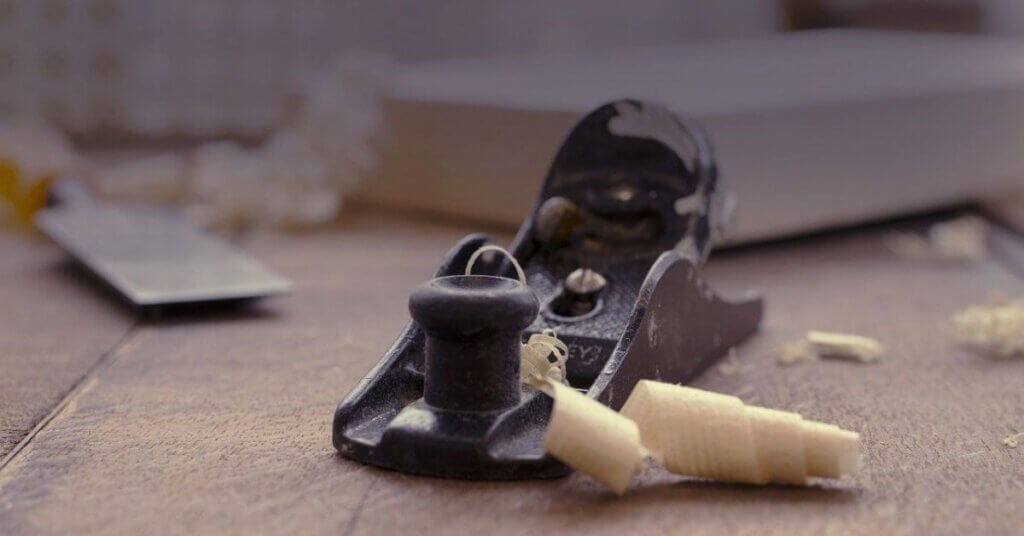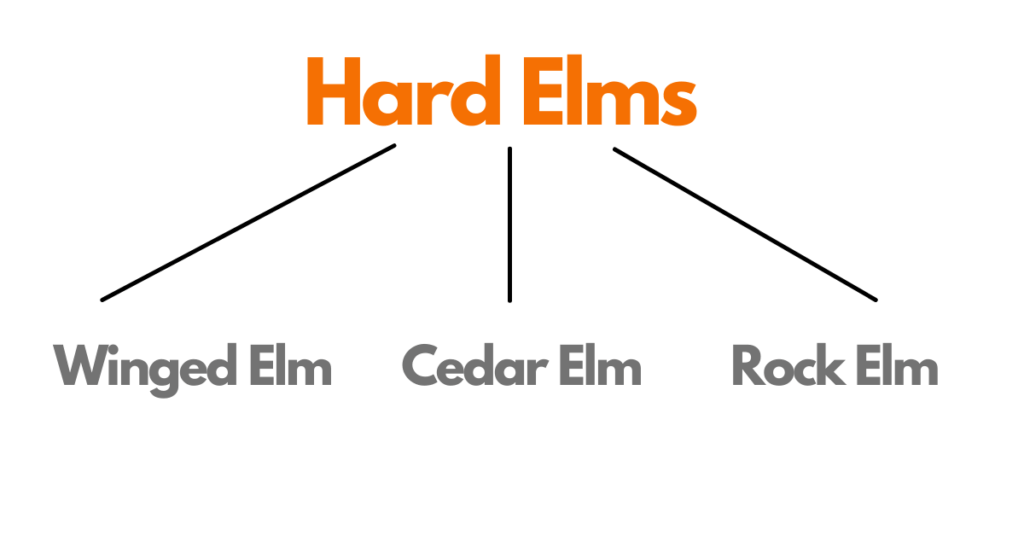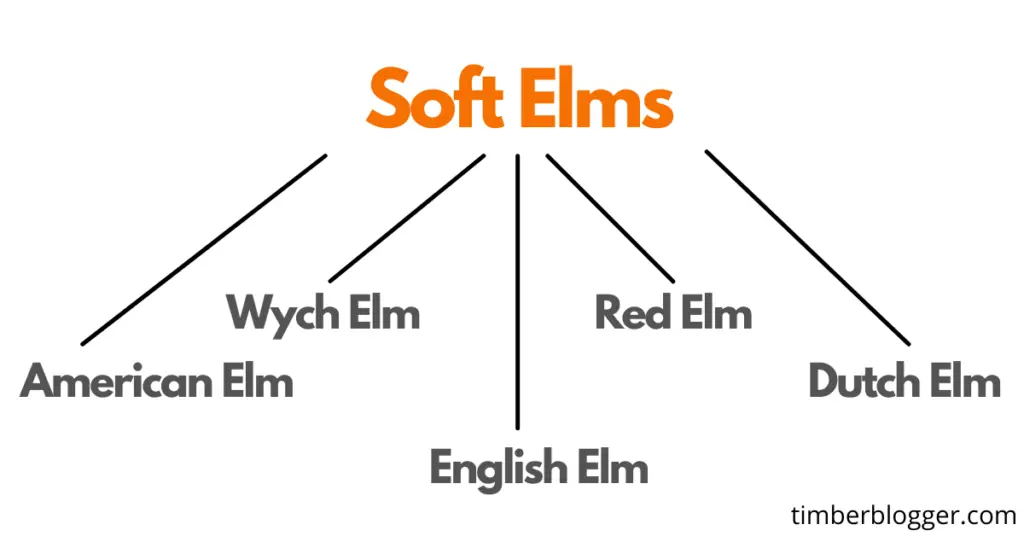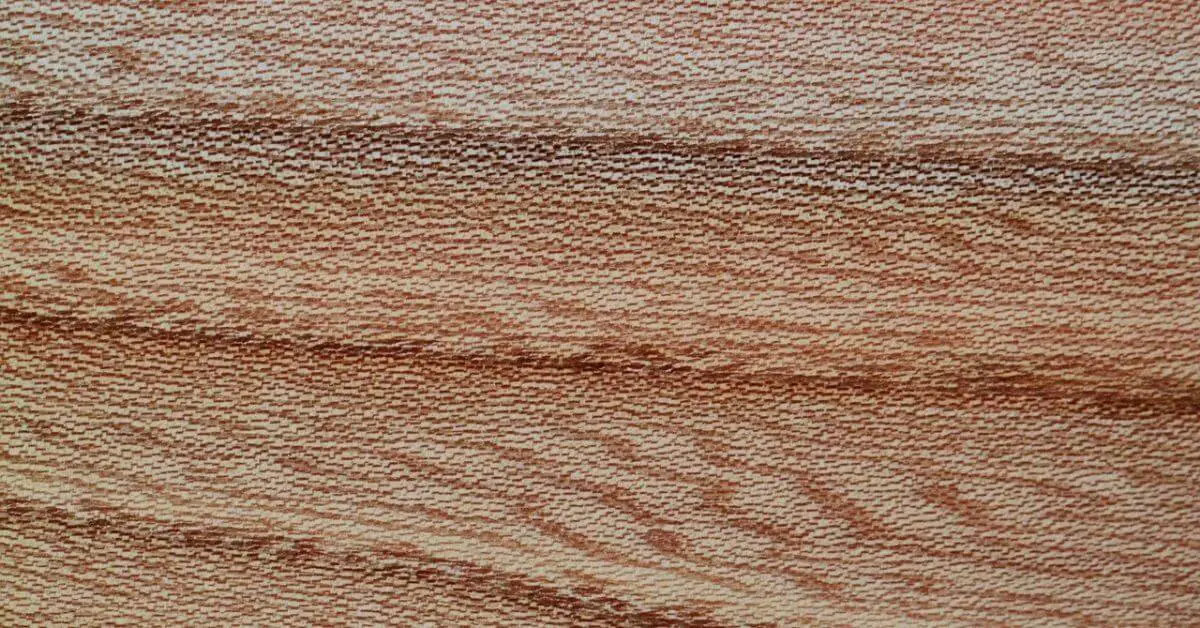What is Elm Wood?
Elms are deciduous and semi-deciduous trees in the genus Ulmus. There are more than 35 species of true Elm. This species is generally found in North America and Western Europe.
The Elm tree is attractive, so it is used as an ornamental tree in Europe, North America, and parts of the Southern Hemis. Commonly it is planted along the park and roadside.
Elm Wood is known for its versatile properties. This is used for making boxes, baskets, furniture, hockey sticks, veneer, etc.
Elm Wood has great strength, durability, toughness, and hardness, and is lightweight. The heartwood of Elm Wood is dark brown and The sapwood is typically white or grayish-white.
Elm Wood Properties
| # | Elm |
| Scientific name | Ulmus |
| Native to | North America and Western Europe |
| Tree Height | 60 to 80 feet tall |
| Hardness | 800 to 900 LBF |
| Workability | can be worked easily. |
| Durability | it is not durable |
| Rot Resistance | Not rot resistance |
| Uses | Boxes, baskets, furniture, hockey sticks, veneer, wood pulp, and papermaking. |
What is Elm Wood Good For?
Furniture: Elm’s appearance is great and grain is interlocking. Hence Elm is used to making strong and quality furniture. Most species of elm are used for making furniture, doors, and windows.
Wood Pulp: Almost all species of elm are widely used for making wood pulp for paper production. About 16% of the total tree population around the world is used for making paper.
Boxes and baskets: Elm is light in weight and strong. It can withstand a heavyweight. This type of wood is perfect for making boxes.
Hilt: Elm’s wood is shock-resistant. It can easily withstand strong shocks. That’s why tool makers use Elm to make wood Hilt.
Elm is not good for these uses
Although Elm is a soft hardwood. Therefore It is susceptible to insect attack, rotting, and rated as non-durable. Therefore it is not considered suitable for outdoor uses. If you want to use it for external purposes then more care is required.
The density of many species of elm is less than that of softwood species. It has been kept in the category of hardwood because of its durability and dark color.
Uses of Elm Trees
Elm trees have great height and attractive foliage. Leaf color is dark green in summer, changing to yellow in fall. It is widely used as an ornamental tree in the United States. American elm is the most famous species to use as an attractive ornamental tree.
The American elm is a highly dense (around 560 kg per cubic meter) shade tree with moderately dense foliage and a crown shape of a broad. It is often found in the park or on the side of the road.
Elm Wood Color and Appearance
Elm is known for its exquisite grain pattern. Its heartwood is light to medium reddish-brown and sapwood has pale to white. Grain is interlocked with a somewhat coarse, uneven texture. Sometimes it can be smooth and straight-grained with a finely waved pattern.
Elm Wood Workability

If we talk about workability, then the workability of Elm Wood is Overall good. Because the density of Elm Wood is low. Can be worked easily with small and machine tools. It can also be easily curved.
But we know that the grain of Elm is interlocked. So It can be a challenge to work sometimes. Especially on quartersawn surfaces. There can also be a problem while planning.
Glue, stain and finish well. Responds well to steam bending, and holds nails and screws well. Elm Wood is that it can be easily stained.
Rot Resistance
Elm Wood does not rate as rot resistance. These are susceptible to insect attacks and rotting. Also, Living trees are susceptible to elm disease.
There are more than fifteen diseases of elm that damage living elm trees. Such as Black leaf spot, Botryodiplodia canker, Dutch elm disease, Ganoderma root rot, Inonotus root rot, Laetiporus root rot, and many more.
How hard is Elmwood?
Elm is a soft hardwood. On the Janka scale, Its hardness varies from 800 to 1,540 lbf. According to the given table. Elm is softer than many softwoods and hardwood.
On the basis of hardness, Elm can be divided into two parts. Soft Elm and Hard Elm. Winged Elm (Ulmus alata), Cedar Elm (Ulmus crassifolia), and Rock Elm (Ulmus thomasii) come in the soft elm category. While American Elm (Ulmus americana), Wych Elm (Ulmus glabra), English Elm(Ulmus procera), etc come in the hard Elm category.
| Elm Species | Janka Hardness |
| American Elm | 830 lbf (3,690 N) |
| English Elm | 810 lbf (3,620 N) |
| Red Elm | 860 lbf (3,830 N) |
| Cedar Elm | 1,320 lbf (5,870 N) |
| Dutch Elm | 850 lbf (3,790 N) |
| Rock Elm | 1,320 lbf (5,870 N) |
| Wych Elm | 990 lbf (4,400 N) |
| Winged Elm | 1,540 lbf (6,850 N) |
How heavy is Elm tree wood?
If a species of elm has 12% moisture content, then the average dry weight would be about 36 pounds per cubic foot. American Elm is the lightest and while Rock Elm is the heaviest species of Elm.
| Elm Species | Average Dried Weight |
| American Elm | 35 lbs/ft3 (560 kg/m3) |
| English Elm | 35 lbs/ft3 (565 kg/m3) |
| Red Elm | 38 lbs/ft3 (600 kg/m3) |
| Cedar Elm | 41 lbs/ft3 (655 kg/m3) |
| Dutch Elm | 36 lbs/ft3 (575 kg/m3) |
| Rock Elm | 47 lbs/ft3 (755 kg/m3) |
| Wych Elm | 38 lbs/ft3 (605 kg/m3) |
| Winged Elm | 42 lbs/ft3 (675 kg/m3) |
Hard Elms

Winged Elm (Ulmus alata)
The Winged Elm is a small- to the medium-sized deciduous tree. It is distributed in the southeastern and south-central United States. Its growth rate is very low (about 5 mm) per year. That’s why its price is high. Winged trees are about 35–50 ft (11–15 m) tall and trunk diameter is 1–2 ft (.3–.6 m).
Appearance and grain: Its heartwood is light to medium reddish-brown and sapwood is usually light yellow. Its grain is interlocked and has an uneven texture. Due to the interlocked grain pattern, It is shock resistant.
Uses: Winged Elm is mainly used for boxes, baskets, furniture, hockey sticks, veneer, wood pulp, and papermaking.
Workability: As we know that Winged Elm has interlocking grain. So it can be difficult to work with small tools and electric machines. Planing can cause tear-out and/or fuzzy surfaces.
Rot Resistance: Winged Elm is rated as non-durable and also susceptible to insect attack. Living trees are susceptible to many diseases.
Cedar Elm (Ulmus crassifolia)
The Cedar Elm is a deciduous tree. It is distributed in South-central North America, mainly in southern and eastern Texas, southern Oklahoma, Arkansas, and Louisiana. Its growth rate is medium (about 12 to 24 inches) per year. But they have a good life span. Cedar Elm trees are about 65-100 ft (20-30 m) tall and trunk diameter is 3-5 ft (1-1.5 m).
Appearance and grain: Its heartwood is light to medium reddish-brown and sapwood is usually light yellow or white. Its grain is interlocked and has an uneven texture. Its appearance is similar to that of Winged Elm
Uses: Cedar Elm is generally used for furniture, hockey sticks, veneer, boxes, baskets, wood pulp, and papermaking.
Workability: Cedar Elm has interlocking grain. Therefore, working with small tools and electric machines can also be difficult. Planing can cause tear-out and/or fuzzy surfaces. But responds well to steam bending, and holds nails and screws well.
Rot Resistance: Cedar Elm is Rated as non-durable and also susceptible to insect attack. Living trees are susceptible to many diseases.
Rock Elm (Ulmus thomasii)
Rock elm is also known as cork elm. The Rock Elm is a deciduous tree. It is native primarily to the Midwestern United States. Its growth rate is medium (about 12 to 15 inches) per year. Rock Elm trees are about 65-100 ft (20-30 m) tall and trunk diameter is about 2-4 ft (.6-1.2 m).
Appearance and grain: Its heartwood is light to medium reddish-brown or brown and sapwood are usually light yellow or nearly white. Its grain is interlocked and has an uneven texture. It is very resistant to splitting due to the interlocked grain pattern.
Uses: Rock Elm is mainly known for making Boxes, baskets, furniture, hockey sticks, veneer, wood pulp, and papermaking.
Workability: Rock Elm can be difficult to work with hand tools and machines because of interlocked grain. Planing can cause tear-out and/or fuzzy surfaces. Use Caution When Working With Rock Elm. Due to its high density, It is heavy.
Rot Resistance: Rock Elm is Rated as non-durable and also susceptible to insect attack. It is not suitable for making outdoor furniture.
Soft Elms

American Elm (Ulmus americana)
American elm is also known as white elm or water elm. It is a famous elm species. The American Elm is a deciduous tree. It is native to eastern North America. Its growth rate is medium (about 12 to 15 inches) per year and it has a long lifespan. American Elm trees are about 65-100 ft (20-30 m) tall and trunk diameter is 2-3 ft (.6-1 m).
Appearance and grain: Its heartwood is light to reddish-brown and sapwood is usually light yellow or nearly white. Its grain is interlocked with a somewhat coarse, uneven texture. Due to the interlocked, it is very resistant to splitting.
Uses: American Elm is used to making Boxes, baskets, furniture, hockey sticks, veneer, wood pulp, and papermaking.
Workability: American Elm is difficult to work, Because of interlocked grain. Planing can cause tear-out and/or fuzzy surfaces. Pre-drilling may be required before nailing and screwing. Due to its lightweight, there may be some ease in working.
Rot Resistance: American Elm is Rated as non-durable and also susceptible to insect attack. It is not suitable for outdoor purposes.
Wych Elm (Ulmus glabra)
Wych elm is also known as Scots elm. It is a large deciduous tree and is found in large numbers. It is distributed in Europe and also found in Iran. Its growth rate is about 12 to 15 inches per year(depends on climates). Wych Elm trees are about 65-100 ft (20-30 m) tall and trunk diameter is 2-4 ft (.6-1.2 m).
Appearance and grain: Its heartwood is light to reddish-brown and sapwood is usually light yellow or nearly white. Its grain is interlocked with a somewhat coarse, uneven texture. Heartwood and sapwood can be easily distinguished.
Uses: Wych elm is used to make Boxes, baskets, furniture, hockey sticks, veneer, wood pulp, and papermaking.
Workability: Due to the interlocked grain pattern, It may be difficult to work. Planing can cause tear-out and cutting blades may need to be changed frequently. Pre-drilling holes are required before nailing and screwing.
Rot Resistance: Wych Elm is not durable as other hardwood and It is susceptible to insect attack and rotting. It is not ideal for outdoor purposes.
English Elm (Ulmus procera)
English Elm is also known as Carpathian Elm. It is distributed in Western Europe. Ulmus procera is one of the largest and fastest-growing deciduous trees. Its tree length is 40 meters (about 130 feet) and the diameter of its trunk is 2 meters (6.5 feet). The largest tree of English elm ever found in England was 46 m (151 ft) tall.
Appearance and grain: Its heartwood is medium reddish-brown and sapwood is usually light yellow or nearly white. Its grain is interlocked and unstructured with a somewhat coarse, uneven texture.
Uses: English elm is used to make furniture, sports equipment, boxes, veneer sheets, wood pulp, and pulpwood.
Workability: Due to the unstructured grain pattern and poor dimensional stability, It is difficult to work. But glues, stains, and finishes well. English elm Responds well to steam bending and holds nails and screws well.
Rot Resistance: English Elm is not durable for outdoor purposes. It is susceptible to rotting. Trees are susceptible to elm disease.
Red Elm(Ulmus rubra)
Red Elm is native to eastern North America. It grows well both in moist and dry places. Ulmus rubra is also known as gray elm, soft elm, moose elm, and Indian elm. Its tree is 50-80 ft (15-24 m) tall, 2-3 ft (.6-1 m) trunk diameter.
Appearance and grain: Its heartwood is low to medium reddish-brown. Grain is interlocked with a somewhat coarse, uneven texture.
Uses: Red Elm is very strong and quite light. So that this is the perfect girl to make furniture. Besides furniture, It is used for boxes, veneer sheets, wood pulp, and pulpwood.
Workability: Due to the Irregular grain pattern and poor dimensional stability, It is difficult to work sometimes. But glues, stains, and finishes well. Also, it responds well to steam bending and holds nails and screws well.
Rot Resistance: Red Elm is not durable for outdoor purposes. It is susceptible to rotting. Trees are susceptible to elm disease.
Dutch Elm (Ulmus × hollandica)
Dutch Elm is a European elm hybrid, coming from U. Glabra x U. minor and a variety of other species. It is also known by the cultivar name ‘Hollandica’. Its tree height is about 80–115 ft (25–35 m) and its trunk diameter is 3-5 ft (1–1.5 m). It grows to about 12 to 15 inches a year.
Dutch elm began to be increasingly used from the eighteenth century onwards. But it is rare in the Netherlands and in many other places
Appearance and grain: Heartwood is light to medium reddish-brown. The sapwood is pale yellow or almost white. Its grain is interlocked and unstructured with a uniform texture.
Uses: Its appearance is great and generally used for making quality furniture, sports equipment, boxes, veneer sheets.
Workability: It can be difficult to work with when the wood is not completely dry, but once it is thoroughly dry, it is easy to work with. But sometimes due to irregular grain, it can be difficult to work.
Rot Resistance: Dutch Elm is not durable for outdoor purposes. It is susceptible to rotting. Trees are susceptible to elm disease.
Final Words
So overall Elm is a great wood species. Which is used from construction to furniture and paper industry. So what do you use or want to use Elm for?
Read also Elm vs Oak

